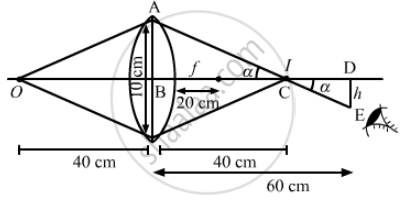Advertisements
Advertisements
प्रश्न
A point object O is placed on the principal axis of a convex lens of focal length f = 20 cm at a distance of 40 cm to the left of it. The diameter of the lens is 10 cm. An eye is placed 60 cm to right of the lens and a distance h below the principal axis. The maximum value of h to see the image is
पर्याय
0
2.5 cm
5 cm
10 cm.
उत्तर
2.5 cm
As the focal length of the lens is 20 cm and object distance is 40 cm from the lens, the image is formed at the centre of curvature at the right side of the lens.
From right angled triangle ABC,
\[\tan\alpha = \frac{AB}{BC}\]
\[\tan\alpha = \frac{5}{40}\]
\[\alpha = \tan^{- 1} \left( \frac{5}{40} \right)\]
and from right angled triangle, we have:
\[\tan\alpha = \frac{AB}{BC}\]
\[\tan\alpha = \frac{5}{40}\]
\[\alpha = \tan^{- 1} \left( \frac{5}{40} \right)\]
and from right angled triangle, we have:
\[\tan\alpha = \frac{AB}{BC}\]
\[\tan\alpha = \frac{5}{40}\]
\[\alpha = \tan^{- 1} \left( \frac{5}{40} \right)\]
Putting the value of angle alpha, we get:
\[\tan\left( \tan^{- 1} \left( \frac{5}{40} \right) \right) = \frac{h}{20}\]
\[\frac{5}{40} = \frac{h}{20}\]
\[ \Rightarrow h = 2 . 5 cm\]
APPEARS IN
संबंधित प्रश्न
Name the phenomenon responsible for it.
Why does unpolarised light from a source show a variation in intensity when viewed through a polaroid which is rotated?
Show with the help of a diagram, how unpolarised light from Sun gets linearly polarised by scattering.
Draw the intensity distribution for the fringes produced in interference ?
Draw the intensity distribution for the diffraction bands produced due to single slit ?
In the meterbridge experimental set up, shown in the figure, the null point ‘D’ is obtained at a distance of 40 cm from end A of the meterbridge wire. If a resistance of 10Ω is connected in series with R1, null point is obtained at AD = 60 cm. Calculate the values of R1 and R2.
Describe briefly using a diagram how sunlight is polarised ?
Suppose you are inside the water in a swimming pool near an edge. A friends is standing on the edge. Do you find your friend taller or shorter than his usual height?
A concave mirror has a focal length of 20 cm. Find the position or positions of an object for which the image-size is double of the object-size.
A candle flame 1.6 cm high is imaged in a ball bearing of diameter 0.4 cm. If the ball bearing is 20 cm away from the flame, find the location and the height of the image.
Locate the image of the point P as seen by the eye in the figure.

k transparent slabs are arranged one over another. The refractive indices of the slabs are μ1, μ2, μ3, ... μk and the thicknesses are t1 t2, t3, ... tk. An object is seen through this combination with nearly perpendicular light. Find the equivalent refractive index of the system which will allow the image to be formed at the same place.
A container contains water up to a height of 20 cm and there is a point source at the centre of the bottom of the container. A rubber ring of radius r floats centrally on the water. The ceiling of the room is 2.0 m above the water surface. (a) Find the radius of the shadow of the ring formed on the ceiling if r = 15 cm. (b) Find the maximum value of r for which the shadow of the ring is formed on the ceiling. Refractive index of water = 4/3.
A paperweight in the form of a hemisphere of radius 3.0 cm is used to hold down a printed page. An observer looks at the page vertically through the paperweight. At what height above the page will the printed letters near the centre appear to the observer?
Answer the following question in detail.
Explain the formation of a primary rainbow. For which angular range with the horizontal is it visible?
Answer the following question in detail.
Is it possible to see primary and secondary rainbow simultaneously? Under what conditions?
Pick the wrong answer in the context with rainbow.
State any one difference between a primary rainbow and a secondary rainbow.
| Case study: Mirage in deserts |
 |
|
To a distant observer, the light appears to be coming from somewhere below the ground. The observer naturally assumes that light is being reflected from the ground, say, by a pool of water near the tall object. Such inverted images of distant tall objects cause an optical illusion to the observer. This phenomenon is called mirage. This type of mirage is especially common in hot deserts. Based on the above facts, answer the following question: |
Which of the following phenomena is prominently involved in the formation of mirage in deserts?
Between the primary and secondary rainbows, there is a dark band known as Alexandar’s dark band. This is because ______.
- light scattered into this region interfere destructively.
- there is no light scattered into this region.
- light is absorbed in this region.
- angle made at the eye by the scattered rays with respect to the incident light of the sun lies between approximately 42° and 50°.
